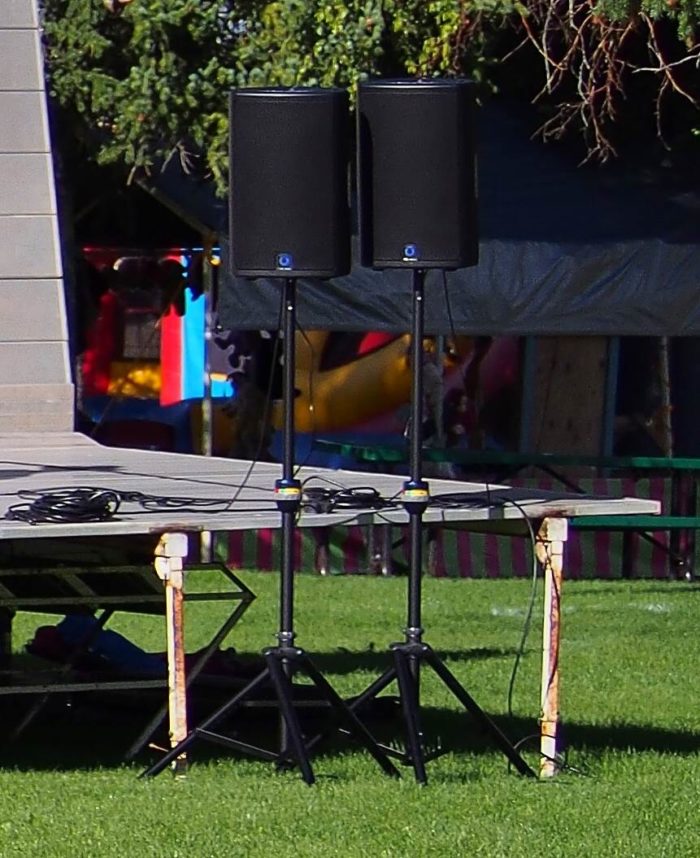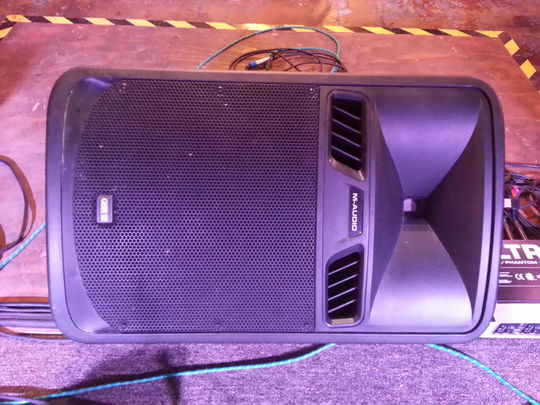A nice box, but flawed.
Please Remember:
The opinions expressed are mine only. These opinions do not necessarily reflect anybody else’s opinions. I do not own, operate, manage, or represent any band, venue, or company that I talk about, unless explicitly noted.

 Want to use this image for something else? Great! Click it for the link to a high-res or resolution-independent version.
Want to use this image for something else? Great! Click it for the link to a high-res or resolution-independent version.When I was adding onto my system last year, I chose Turbosound Milan as the product line for FOH. Since putting those boxes into service, my feelings have been mixed. The most mixed of those feelings have been reserved for the mid-highs I chose, designated as “M12” by the manufacturer.
I do like the compact nature of the package. Other powered 12s that I carry are similar in weight, but inefficient in their use of bulk. The Milans chew up less space, and yes, they have a monitor-angle on both sides. You can properly book-match a pair of the little darlings, which is something I appreciate.
I also like the overall fit and finish. Yes, they’re plastic boxes, but it’s the kind of plastic that can take some wear gracefully. The controls and connection points seem to be reasonably well-engineered, with slide switches that clearly indicate where they’re set. (Push-toggles are fine if they unambiguously show their state, but plenty of them don’t – so, kudos to Turbosound on this front.) I often work with other boxes that really are just fine…but feel “cheap” when it comes to XLR connectors and back-panel interaction. The Milans are a definite upgrade there.
M12s do seem to be tuned pleasingly at the factory, which is a big help for throw-n-go gigs where you have to make things work out tonally without a lot of prep time. Your mileage may vary, of course, especially since just about anything can be whipped into shape these days.
Also, let’s be honest: My anti-establishment nature has a special place for brands that are less common. Everybody knows JBL, Peavey, EV, Yamaha, and so on, but Turbosound is a loudspeaker marque that’s a little less trafficked in small-format circles. (Turbo’s big-boy boxes are more well known to the folks who work at that level.)
What do I not like? Well…
Milan M12s are a (tiny) bit expensive for what you get – both in money and weight. When JBL marked their Eon 612s down, they really threw the gauntlet at Turbo. Spend $50 less, get a box that has essentially the same performance, and save about 12 lbs.
…and Turbo, geeze, can we please have a real “thru” on the back? Sometimes I just want to chain two boxes together, and I don’t want to have to volume-match them by ear. Especially if I’ve forgotten to do so before the speakers are eight feet in the air already.
But that’s not the biggest thing.
What really put me off with the M12s was how they will audibly distort before they illuminate their clip indicators. It’s not a horribly nasty sound, but its “too obvious” and a little embarrassing. When somebody addresses the crowd at concert level, using a mic that has some low-mid dialed into it, there’s no reason that a loudspeaker of this type should suddenly give the impression of being underpowered. Sure, these units travel with the crowd that peaks under 130 dB SPL @ 1 meter, but so do my Eons and they don’t seem to misbehave when still running “in the green.” I was so unsettled by this quirk of the Turbos that I retired them to moderate-volume-only use – which they are great at, I should mention.
Someone might point out that the Turbosounds could simply dislike my gain structure. I often run powered loudspeakers with the input controls at full-throttle (when it’s practicable), because full-throttle is an easily repeatable setting. Also, I know I can get maximum SPL at around -20 dBFS on my console outputs. I can’t discount the possibility that the M12s fail to handle that kind of use gracefully at the input side, which means that my dislike is user-error. At the same time, though, I have to go back to my JBL Eons; They tolerate being run wide-open without any marked complaint, which is what I expect from a loudspeaker in this price-range.
Milan M12s are good, but they don’t seem to be good enough to spend “more money” on.

 Out of six GSR-12s originally purchased, only three have survived. Here’s one of the units that still works.
Out of six GSR-12s originally purchased, only three have survived. Here’s one of the units that still works. There’s another GSR that you can’t see here. That one’s completely dead, and in another closet. These are the two that I could get to without a lot of fumbling around.
There’s another GSR that you can’t see here. That one’s completely dead, and in another closet. These are the two that I could get to without a lot of fumbling around.